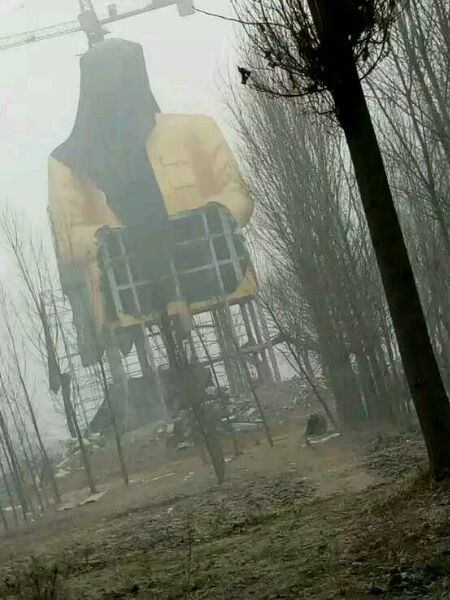Is Cabot Circus employing Smurfs?
The modern mobile phone is a sophisticated and very useful item: mine is a miniature marvel – a Linux-based computer that fits comfortably in the hand, plays music, acts as a radio, takes video and still images and also allows me to make telephone calls.
Venturing into central Bristol, one notices that nearly everyone one passes has one and entering the Cabot Circus shopping centre – that latter day monument to retail therapy – is no exception to this general observation.
Having noticed a couple of years ago that visitors to Cabot Circus have their progress around that Temple of Mammon tracked by means of their mobile phone signal (posts passim), it has been my practice ever since to turn my mobile phone off before entering; and I don’t turn it back on until I’m well clear.
 It’s bad enough being tracked from shop to shop, but there’s another threat to the privacy and security of mobile phones and their users in Cabot Circus… but you’ll only discover it if you happen to use the mobile phone charging points (shown left) kindly provided by the centre’s management.
It’s bad enough being tracked from shop to shop, but there’s another threat to the privacy and security of mobile phones and their users in Cabot Circus… but you’ll only discover it if you happen to use the mobile phone charging points (shown left) kindly provided by the centre’s management.
On the face of it, these charging points – 3 in number – are a boon to visitors. After all, who hasn’t been in a situation where one’s battery is running low. It does seem benevolent of the managers of Cabot Circus to provide half an hour’s gratis battery top-up, doesn’t it?
Now, you remember me saying about turning my phone off before entering? Good! With my device switched well and truly OFF I have now placed my phone in the recharging facility whilst paying a call of nature. Upon return a few minutes later, I have in each instance retrieved by phone from the locker – and found it to be switched ON!
Needless to say out of consideration for my security and privacy, I shall not be using one of these charging points again.
As regards using the mobile phone charging points, the Cabot Circus website states the following:
Because we want our visitors to have a stress free [sic] shopping experience within our centre, Cabot Circus has now installed three ChargeBox phone charging stations, ideal for when your battery goes flat at the most inconvenient times.
Easy to use in three simple steps, connect your phone, lock, take the key and relax. The ChargeBox stations allow you to charge your phones for free and enjoy 30 minutes extra shopping time!
The ChargeBox stations at Cabot Circus are located:
– Level 1 outside Costa
– Upper Ground at the Information Desk
– Ground floor toilet lobby
Curiously, there’s nothing in the above text that I can see about the points’ ability to turn on a mobile phone that’s been switched off.
However, let’s be generous and assume that specific piece of information was omitted by mistake. 🙂
When I charge my turned-off phone elsewhere, either by using a USB cable connected to a PC/laptop or the adapter that came with it, it definitely stays off. That being so, I began thinking how could the lovely folk at Cabot Circus generously providing me with free electricity be turning my phone back on when I’d left it firmly switched off.
A quick internet search reveals no logical or plausible benign explanation as to why a switched-off phone is turned on by the charging station.
The only tools of which your correspondent is aware for doing such things to a mobile phone is the Smurf suite of tools used by the British State’s snoopers at GCHQ, as revealed by NSA whistleblower Edward Snowden. In this suite of tools, one called “Dreamy Smurf” can allegedly turn a phone on or off, whilst another called “Nosey Smurf” can activate a phone’s microphone to use it for audio surveillance. “Tracker Smurf” is a geo-location tool that Snowden says offers a more accurate method of locating a phone and its carrier than using triangulation. Another Smurf can operate a smartphone’s camera, while “Paranoid Smurf” does its best to hide the activities of the other Smurfs.
One therefore has to wonder whether that the operators of Cabot Circus, by turning visitors’ phones on, are infringing their privacy and presenting a security threat to their mobile devices.
Care to come clean, Cabot Circus, on whether you’re employing Smurfs or using something analagous?









 Computer system failures in the aeronautical world are nothing exceptional, but always have a far-reaching effect, stranding thousands of passengers on the ground. This is exactly what happened last Saturday at Orly which had to halt of all its inbound and outbound air traffic for more than half an hour. Besides the inconvenience caused, it’s above all the origin of the failure that is somewhat surprising. According to the French satirical paper
Computer system failures in the aeronautical world are nothing exceptional, but always have a far-reaching effect, stranding thousands of passengers on the ground. This is exactly what happened last Saturday at Orly which had to halt of all its inbound and outbound air traffic for more than half an hour. Besides the inconvenience caused, it’s above all the origin of the failure that is somewhat surprising. According to the French satirical paper